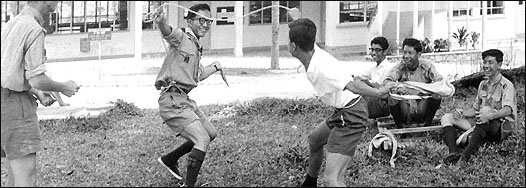
 n the 1950 s, Kuala Lumpur was still clad with rubber estates and
forest, especially outside the city centre. Despite newly-gained
independence it was an era when affluence was still the privilege of a
select few. Besides, affluence could not guarantee safety as the
restrictions of the Malayan Emergency applied indiscriminately to all
people. It is in this political, economic and social milieu that one
should place the developments of V.I. Scouting between 1955 and 1963.
n the 1950 s, Kuala Lumpur was still clad with rubber estates and
forest, especially outside the city centre. Despite newly-gained
independence it was an era when affluence was still the privilege of a
select few. Besides, affluence could not guarantee safety as the
restrictions of the Malayan Emergency applied indiscriminately to all
people. It is in this political, economic and social milieu that one
should place the developments of V.I. Scouting between 1955 and 1963.
Facilities of any kind were not easy to come by. In terms of transportation, the Scouts usually biked to the nearer spots, like Klang gates and Pongsoon Dusun Tua, and Kepong. When bikes could not carry their equipment, they were dropped off by their families. A lot of times, they just hiked from the School with their equipment. Navigation was not difficult given the light traffic of those times! For camping trips out of town, some parents (especially the wealthier ones) would provide a chauffeur and station wagon, usually a trusty Peugeot, Austin or Hillman to ferry the Scouts. Some ASM s would drive their own cars, all loaded up with tents and other equipment on the roof, to distant destinations like Pangkor. Then there were train trips, or bus rides to those far off places. For instance, the Scouts could take a bus from Foch Avenue (now Jalan Cheng Lock) to Seremban, then change buses for Port Dickson. Such was living simply.
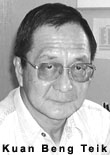
Yet, living simply did not necessarily mean that the Scouts had a hard time. Indeed, the Scouts had an enjoyable time whenever they put their Scouting skills to full use. One aspect of this was camp life. As Koh Tong Bak (First KL ASM and Pengakap Raja) and Kuan Beng Teik (Second KL ASM, Pengakap Raja and School Captain 1963) recall, they usually ate well at camp, depending on where the camp was. The First KL Scouts would usually send two Scouts on behalf of the entire troop to the local market to buy fresh food while in Second KL, they sent the Treasurer as the representative. Sometimes, these marketing boys could get fish, poultry or vegetables from the generous local residents for free! Back at camp, the Scouts cooked mostly curry (chicken or beef) and of course vegetables (especially long beans which kept well, and potatoes and large onions). Every boy brought at least one tin of canned food, usually Spam (the famous staple - spiced ham - of the US Forces during World War 2), corned beef or sardines, but they tried to get fresh ingredients every morning. Tong Bak also recalls that sometimes, he even bought a whole leg of lamb or rabbit meat (from Cold Storage) that they cooked over the campfire like a real barbecue.
But while the Scouts had a grand time, not all was right with the V.I. Scouting movement.
SHORTAGE OF EXPERIENCED AND WILLING SCOUT MASTERS
When the Emergency was declared in 1948, it was not simply
a far-off political move. There was a demand for fit and loyal citizens to
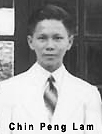 join the military or police or at least to "help in the fight against
Banditry", as urged by the authorities at that time. This message
was strongly felt by Second KL when Mr Chin Peng Lam, their Scout Master,
left to become a Police Inspector on 4 June 1954. His skills as a
Woodbadger would have equipped him well to undertake such an important
service to his country. But for Second KL, it left a vacuum that was to
transform the administrative structure of the Group. Due to the absence
of a Scout Master in the Boy Scout Troop, what more a skilled one, student
leaders had to fill the vacuum. Since the boys were in their formative
years and were less mature or autonomous than the Senior Scouts, the role
of the leader was extremely crucial. Arguably, the student Scout leaders
(the main ones have been named in this section) of the 1950 s and early
were pioneers in this experiment.
join the military or police or at least to "help in the fight against
Banditry", as urged by the authorities at that time. This message
was strongly felt by Second KL when Mr Chin Peng Lam, their Scout Master,
left to become a Police Inspector on 4 June 1954. His skills as a
Woodbadger would have equipped him well to undertake such an important
service to his country. But for Second KL, it left a vacuum that was to
transform the administrative structure of the Group. Due to the absence
of a Scout Master in the Boy Scout Troop, what more a skilled one, student
leaders had to fill the vacuum. Since the boys were in their formative
years and were less mature or autonomous than the Senior Scouts, the role
of the leader was extremely crucial. Arguably, the student Scout leaders
(the main ones have been named in this section) of the 1950 s and early
were pioneers in this experiment.
This philosophy soon drove change in Second KL. After three
years of Mr Chin as the redoubtable Scout Master of the Boy Scouts, Second KL had
problems replacing him. In the 1955 Victorian , the Scout Master name
slot on the roll of honour reads: "Applications invited - but only the
brave need apply!" So formidable was his reputation that the Second KL
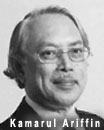 Troop secretary, Jeff (probably ASM Jaafar b. Sidek), could not resist the
temptation to lampoon him further with "since then (Mr Chin becoming a
Police Inspector) most of the boys have been arrested for something or other!
" Only a person of similar charisma would dare to step into the shoes of
such a leader - and there was no replacement more suitable than Kamarul
Ariffin b. Mohamed Yassin (See A Gallery of Scouting
Greats). Kamarul returned to the school in 1954 to do his Post-Senior
Cambridge, and assumed the role of Scout Master (having previously been ASM).
However, this plan was short-lived as, after a few months, he left to read
Law at Lincoln s Inn, perhaps after "successfully laying down the law
to a lot of very naughty Scouts" (as quoted from the 1955
Victorian). After Kamarul left, Queen Scout ASM Jaafar b. Sidek had to
helm the troop alone, in his third consecutive year as ASM of the Boy Scouts.
Meanwhile, the dearth of scouters was beginning to be felt by the Second KL
Seniors when S.M. Mr Geoffrey Geldard left in the beginning of 1956 after
Troop secretary, Jeff (probably ASM Jaafar b. Sidek), could not resist the
temptation to lampoon him further with "since then (Mr Chin becoming a
Police Inspector) most of the boys have been arrested for something or other!
" Only a person of similar charisma would dare to step into the shoes of
such a leader - and there was no replacement more suitable than Kamarul
Ariffin b. Mohamed Yassin (See A Gallery of Scouting
Greats). Kamarul returned to the school in 1954 to do his Post-Senior
Cambridge, and assumed the role of Scout Master (having previously been ASM).
However, this plan was short-lived as, after a few months, he left to read
Law at Lincoln s Inn, perhaps after "successfully laying down the law
to a lot of very naughty Scouts" (as quoted from the 1955
Victorian). After Kamarul left, Queen Scout ASM Jaafar b. Sidek had to
helm the troop alone, in his third consecutive year as ASM of the Boy Scouts.
Meanwhile, the dearth of scouters was beginning to be felt by the Second KL
Seniors when S.M. Mr Geoffrey Geldard left in the beginning of 1956 after
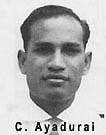 three years of service to the Troop. His departure was followed by Queen
Scout ASM Yoong Wah Pin (ASM since 1953), who retired in order to concentrate
on his HSC.
three years of service to the Troop. His departure was followed by Queen
Scout ASM Yoong Wah Pin (ASM since 1953), who retired in order to concentrate
on his HSC.
Such forces of changes in administration structure were not unique to Second KL, though First KL experienced less turbulent change. In the Senior Troop, Mr Wong Peng Kong, the Scout Master since 1952, left after 1956 (he returned in 1959). During his absence, there was no teacher willing to take up the post. Meanwhile, the Boy Scout Troop also had a shortage of leaders in the mid-1950 s and the Scout Master Mr C. Ayadurai was saddled with the onerous burden of leading the Troop alone. Mr Yeoh Chong Bok took over that role in 1957.
Fortunately, amidst the storm, there were two sturdy rudders
to provide continuity to the V.I. Scouts in the form of their Group Scout
Masters. For Second KL, Mr T.J. Appaduray served the Group from 1955 to
1964. A for First KL, GSM Mr Sadhu Singh was replaced by Mr Chan Bing Fai,
who held the post between 1955 and 1965. Mr Chan had himself been a Scout
in Second KL while in the V.I. as a student, and he had been at Kirkby,
England between 1952 and 1954. (See An Evening With
Two Former Scout Masters (2001).) Interestingly, Mr Chan has had a
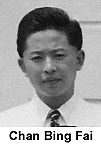 spiritual connection with the V.I. scouts even before he became Scout
Master. When he was a student at Batu Road Primary School, one of Mr
Chan s teachers was Mr Choong Wan Chan, the first King Scout of the V.I.
and of Selangor. Thus, who better to hold the post of GSM than someone
with such a spiritual connection?
spiritual connection with the V.I. scouts even before he became Scout
Master. When he was a student at Batu Road Primary School, one of Mr
Chan s teachers was Mr Choong Wan Chan, the first King Scout of the V.I.
and of Selangor. Thus, who better to hold the post of GSM than someone
with such a spiritual connection?
In essence, there were two major problems that befell the V.I. Scouts in the mid-1950 s, namely a dearth of leaders and (to be discussed later) an acute shortage of members. Indeed, with these problems, the quality of Scouting and the attractiveness of the Group were put at risk. The Fourth KL Air Scout Group had suffered from both problems even in the early 1950 s. As Mr Chan Bing Fai and Mr Chin Peng Lam recall, the Fourth KL Group always emerged last among the V.I. Scout Groups during the Scout Event at Sports Day in the early 1950 s. Ensuring the survival of the Group necessitated some administrative shuffling such as the transfer of GSM Mr Sadhu Singh (formerly the First KL Group Scout Master) to take charge of the Fourth KL Group in 1955. However, this could not delay the inevitable where the Fourth KL Air Scout Group had to be amalgamated with First KL in 1955.
LEADERSHIP RESPONSIBILITIES AND THE STUDENTS
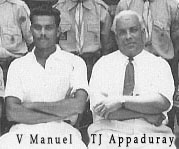
How did the remaining Troops solve their leadership problems? In short, through the return of dedicated elder ex-Scouts to take up leadership positions. For First KL, these dedicated Scouts included Nasir Ahmad Ibrahim and Chen Yik Fei (Scout Masters of the Seniors 1957 to 1959) and also Ooi Boon Teck and Arnold S. (ASM s in 1956). As for Second KL, after his HSC, Jaafar Sidek became the Scout Master of the Seniors. As for the Second KL Boy Scouts, they were fortunate to find a willing teacher in Mr Valentine Manuel, who became their Scout Master in 1957/1958. After the turbulent mid-1950 s, the turmoil in the administration of both Groups soon dispersed, at least for a while.
Then in the early 1960 s, Second KL again experienced a lack
of people interested in becoming Scout Masters of either their Boy Scout or
Senior Troops. After 1959, when Mr Valentine Manuel left, there were no Scout
Masters for both the Boy Scout and Senior Troops for several years, except
Mr David Waghorn from Kinrara Hospital who was temporarily Scout Master of
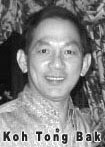 the Seniors in 1960. This increased the importance of the role of the ASM and
student leaders in Second KL in particular and the V.I. Scouting movement in
general. This wave of change also swept through the First KL Group. However,
their change occurred not so much because of the lack of Scout Masters, but
because of the frequent change in Scout Masters after the 1950 s. Mr Yeoh
Chong Bok left the Boy Scouts after 1962 and Mr Wong Peng Kong left the
Seniors after 1963. Hence, there was an increased onus placed on the ASM s to
shoulder the responsibilities that hitherto were a Scout Master s. In fact,
there was a further decentralisation of power in 1963. That year, the First
KL Seniors had no Scout Master when Koh Tong Bak and Lim Pang Hon (both
ASM s) left for university and there was no one to fill their shoes.
As a result the administration of the Senior Troop was delegated to the Senior
Scout Court Of Honour (COH), consisting of the Troop Leader and Senior Patrol
Leaders. The COH's role eventually grew in importance in both Groups, to the
extent that it was choosing the agenda for weekly Troop meetings, as well as
discussing and solving problems of the Troop with the Scouters.
the Seniors in 1960. This increased the importance of the role of the ASM and
student leaders in Second KL in particular and the V.I. Scouting movement in
general. This wave of change also swept through the First KL Group. However,
their change occurred not so much because of the lack of Scout Masters, but
because of the frequent change in Scout Masters after the 1950 s. Mr Yeoh
Chong Bok left the Boy Scouts after 1962 and Mr Wong Peng Kong left the
Seniors after 1963. Hence, there was an increased onus placed on the ASM s to
shoulder the responsibilities that hitherto were a Scout Master s. In fact,
there was a further decentralisation of power in 1963. That year, the First
KL Seniors had no Scout Master when Koh Tong Bak and Lim Pang Hon (both
ASM s) left for university and there was no one to fill their shoes.
As a result the administration of the Senior Troop was delegated to the Senior
Scout Court Of Honour (COH), consisting of the Troop Leader and Senior Patrol
Leaders. The COH's role eventually grew in importance in both Groups, to the
extent that it was choosing the agenda for weekly Troop meetings, as well as
discussing and solving problems of the Troop with the Scouters.
Whilst over the years many ASM s came and went, there is one ASM deserving of special mention. In early 1960, First KL was joined by a new ASM in the person of Corporal John Lever of the R.E.M.E. then stationed in Gurney Road. Convinced of his capabilities and dedication, the First KL Seniors approached and persuaded him to become their ASM. Lever was a treasured find as he contributed much towards the Troop. For instance, on 2 June 1961, First KL was presented with a thousand dollars worth of camping equipment by the 656 Light Aircraft Squadron who were stationed at Malaya Command (Lever himself was a member of the squadron). By the time John Lever returned to England on 24 February 1962, he had left a myriad of happy memories for the First KL Seniors to cherish. Together with SM Mr Wong Peng Kong, ASM Corporal Lever imparted many skills, such as mountaineering, and inspired the First KL Seniors to a very high level of Scouting ability.
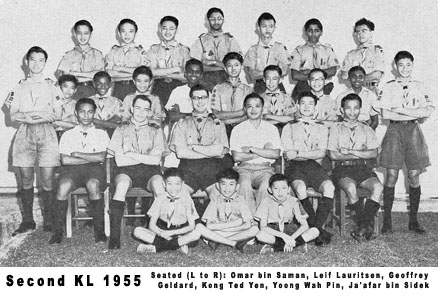
Indeed, the role of Scout leaders in lifting the standards of a Troop cannot be underestimated. Mr Wong, who worked in the mapping department of the Government, served as SM of the First KL Seniors from 1952 to 1956 and 1959 to 1963. He was then the ADC for Kuala Lumpur and inspired his charges with many stories and disciplined them to rigid standards. It is said that he would string pieces of campsite scrap into a necklace and drape it around an errant PL s neck. Alternatively, he would bring out a 'supposedly' dirty/used underwear/ brief of his, soak it in a pan of water, and squeeze it over the offender's head!
COMMITMENT TO SCOUTING - MEMBER SHORTAGE
The scenario of rapid change around and within the V.I. scouting movement surely had much impact on the movement itself. Many questions can be asked. What was the effect of the 1954 departure of Sir Gerald Templer, Chief Commissioner of Scouting in Malaya and a good friend of the V.I. scouts? What happened as a result of the flux and reflux in the administration of the two V.I. Troops? To answer these questions, one must examine the commitment towards V.I. Scouting, particularly in terms of its popularity and in terms of its ability to produce skilled members.
Whilst the V.I. Scouting movement was very popular in its infant years, and even just after the Second World War, the numbers started dwindling rapidly in the mid-1950 s. There are many possible explanations. For instance, just after the War, the Scouts were the only uniformed movement in the School and when the Cadet Corps was rejuvenated in 1953, the Scouts had to share its recruit pool with them. Another possible reason is that the machismo of the Cadet Corps may have been more attractive during that period of the Malayan Emergency. Whatever the reason, it was undeniable that one of the lowest ebbs in the V.I. Scouting membership base was reached during the mid-1950 s. In Second KL, there was a private joke that "there were more Scouters than Scouts!". First KL was not trouble-free either, even after amalgamating with Fourth KL. As Koh Tong Bak recalls, he may have been the only Form 1 recruit in 1956 for First KL! Even in 1957, the Troop Secretary for First KL reported that "... the Troop has not been very active."
Below is a table of the membership strength of both Troops:
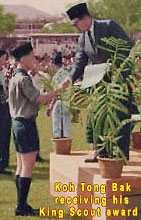
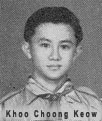 Class badges. Those who had in fact gained their First Class Badges were
four Senior Scouts, while two other Senior Scouts earned the Bushman s
Thong. TL Lee Chan however, was the toast of the troop for that year when
he became a Queen Scout. Meanwhile, seven Second KL Scouts obtained their
First Class badges, with PL Chong Sun Yeh gaining the Scout Cord (the Boy
Scout equivalent of the King Scout award). In the Senior Troop of Second
KL, four Queen Scouts were produced in 1956, namely PL Low Thin Wing, Teh
Kein Seng, PL Khoo Choong Keow and S Sundram, while three others gained
their Bushman s Thong. In contrast to this spectacular achievement, one
year later, in 1957, little is reported about badge accomplishments,
except that one Second KL Senior had gained his Bushman s Thong. The 1958
Victorian also failed to mention badge achievements.
Class badges. Those who had in fact gained their First Class Badges were
four Senior Scouts, while two other Senior Scouts earned the Bushman s
Thong. TL Lee Chan however, was the toast of the troop for that year when
he became a Queen Scout. Meanwhile, seven Second KL Scouts obtained their
First Class badges, with PL Chong Sun Yeh gaining the Scout Cord (the Boy
Scout equivalent of the King Scout award). In the Senior Troop of Second
KL, four Queen Scouts were produced in 1956, namely PL Low Thin Wing, Teh
Kein Seng, PL Khoo Choong Keow and S Sundram, while three others gained
their Bushman s Thong. In contrast to this spectacular achievement, one
year later, in 1957, little is reported about badge accomplishments,
except that one Second KL Senior had gained his Bushman s Thong. The 1958
Victorian also failed to mention badge achievements.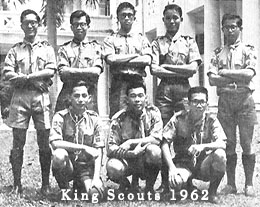 Scouts, there was also much progress with proficiency badges like Cook and
Camp badges as well as Athlete and Swimmer badges. The 1960 Victorian
noted that, in the previous year, two Boy Scouts had gained the Scout
Cord. Second KL also had good news to report in 1959. Some boys who had
joined the troop at the beginning of the year had already passed Second
Class and were well on their way towards First Class.
Scouts, there was also much progress with proficiency badges like Cook and
Camp badges as well as Athlete and Swimmer badges. The 1960 Victorian
noted that, in the previous year, two Boy Scouts had gained the Scout
Cord. Second KL also had good news to report in 1959. Some boys who had
joined the troop at the beginning of the year had already passed Second
Class and were well on their way towards First Class. 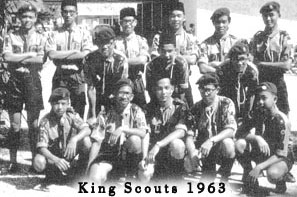 24 February (in commemoration of Founders Day on 22 February) at Castle Camp.
In 1963, there were four Pengakap Raja s and two Bushman s Thong holders among
the First KL Seniors while there were seven Pengakap Rajas in the Second KL Senior Troop.
24 February (in commemoration of Founders Day on 22 February) at Castle Camp.
In 1963, there were four Pengakap Raja s and two Bushman s Thong holders among
the First KL Seniors while there were seven Pengakap Rajas in the Second KL Senior Troop. 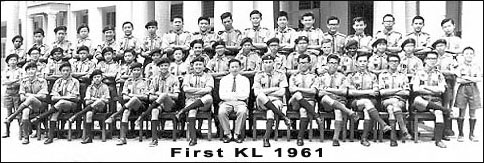
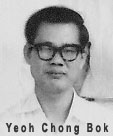 as pioneering, first aid, camping, games, contests and swimming would win
the trophy. Second KL Boy Scouts also had their inter-patrol competitions,
though instead of termly, theirs was monthly, as stated in the 1959, 1960
and 1961 Victorians. The month s best patrol was awarded a shield
together with a prize. It was a little later before the First KL Seniors
also had a prize for inter-patrol competitions when a beer mug was presented
by ASM John Lever. The 1963 Victorian recorded that the competition
was staged during fortnightly meetings and culminated in a competition in Port
Dickson during the first term holidays. The second term saw an inter-Senior
patrol games competition, where patrols competed against each other in Badminton,
Swimming, Basketball, Table Tennis and Athletics. Likewise, the Second KL
Seniors also had inter-patrol competitions based on Tenderfoot, Second and
First Class work in the form of games, swimming, obstacles, contests and
building of pioneering projects.
as pioneering, first aid, camping, games, contests and swimming would win
the trophy. Second KL Boy Scouts also had their inter-patrol competitions,
though instead of termly, theirs was monthly, as stated in the 1959, 1960
and 1961 Victorians. The month s best patrol was awarded a shield
together with a prize. It was a little later before the First KL Seniors
also had a prize for inter-patrol competitions when a beer mug was presented
by ASM John Lever. The 1963 Victorian recorded that the competition
was staged during fortnightly meetings and culminated in a competition in Port
Dickson during the first term holidays. The second term saw an inter-Senior
patrol games competition, where patrols competed against each other in Badminton,
Swimming, Basketball, Table Tennis and Athletics. Likewise, the Second KL
Seniors also had inter-patrol competitions based on Tenderfoot, Second and
First Class work in the form of games, swimming, obstacles, contests and
building of pioneering projects.
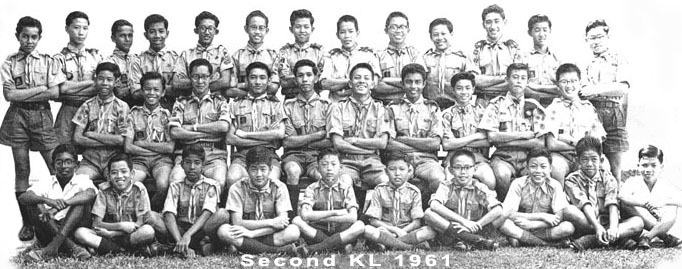
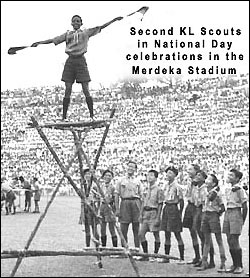 when Hiu Siew and Ah Sze Keledek set up a trading village at the confluence
of the Klang and Gombak rivers), sought the professionalism of the V.I.
Scouts. Nonetheless, the V.I. Scouts did not only serve in grand public
events. During Job Weeks, they excelled themselves in a variety of cleaning jobs,
cleaning of cow-dung included in its range! According to Kuan Beng Teik,
School Captain 1963 and Second KL King Scout, they used to visit
Government officials and expatriate enclaves such as Ampang Road, Kenny
Hills and Circular Road for Job Weeks.
when Hiu Siew and Ah Sze Keledek set up a trading village at the confluence
of the Klang and Gombak rivers), sought the professionalism of the V.I.
Scouts. Nonetheless, the V.I. Scouts did not only serve in grand public
events. During Job Weeks, they excelled themselves in a variety of cleaning jobs,
cleaning of cow-dung included in its range! According to Kuan Beng Teik,
School Captain 1963 and Second KL King Scout, they used to visit
Government officials and expatriate enclaves such as Ampang Road, Kenny
Hills and Circular Road for Job Weeks. 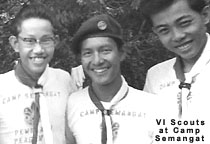 even Kuala Lumpur in the 1950 s were still undeveloped. Nonetheless, the
V.I. Scouts could always find campable sites by being resourceful and by
avoiding being fussy. One example of such resourcefulness deserves a special
mention, because it resulted in the creation of the National Scout Camp for
Malaya. This was Camp Semangat, now known as Kem Sardon Jubir, located in
Balakong, on the outskirts of Kuala Lumpur, newly created in 1956. The site
was developed thanks to the efforts of Mr Geoffrey Geldard, the Scout Master
of the Second KL Seniors. In fact, it was the V.I. Scouts then who helped to
plant trees on that site. Even today in 2002, it is one of the official scout
camping sites of the Persekutuan Pengakap Malaysia, but lest we forget, it
was the V.I. scout movement that contributed to its genesis in the
mid-1950 s!
even Kuala Lumpur in the 1950 s were still undeveloped. Nonetheless, the
V.I. Scouts could always find campable sites by being resourceful and by
avoiding being fussy. One example of such resourcefulness deserves a special
mention, because it resulted in the creation of the National Scout Camp for
Malaya. This was Camp Semangat, now known as Kem Sardon Jubir, located in
Balakong, on the outskirts of Kuala Lumpur, newly created in 1956. The site
was developed thanks to the efforts of Mr Geoffrey Geldard, the Scout Master
of the Second KL Seniors. In fact, it was the V.I. Scouts then who helped to
plant trees on that site. Even today in 2002, it is one of the official scout
camping sites of the Persekutuan Pengakap Malaysia, but lest we forget, it
was the V.I. scout movement that contributed to its genesis in the
mid-1950 s!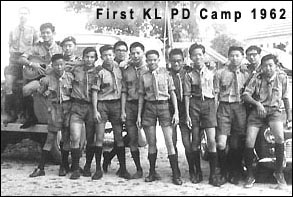 1950 s (Mr Chin Peng Lam recalls that everyone in Second KL had a nickname
and Kamarul s was Blue Panther ).The benefits of establishing such
regular camping schedules were many. The scouts would have time-frames to
set goals for improving their Scout skills in readiness for the upcoming
camp. For the leaders, such traditions gave them a basic planning
framework for organising activities.
1950 s (Mr Chin Peng Lam recalls that everyone in Second KL had a nickname
and Kamarul s was Blue Panther ).The benefits of establishing such
regular camping schedules were many. The scouts would have time-frames to
set goals for improving their Scout skills in readiness for the upcoming
camp. For the leaders, such traditions gave them a basic planning
framework for organising activities.